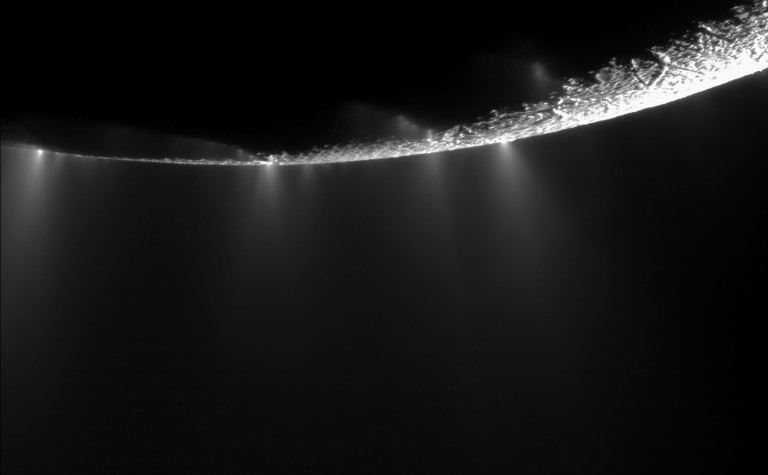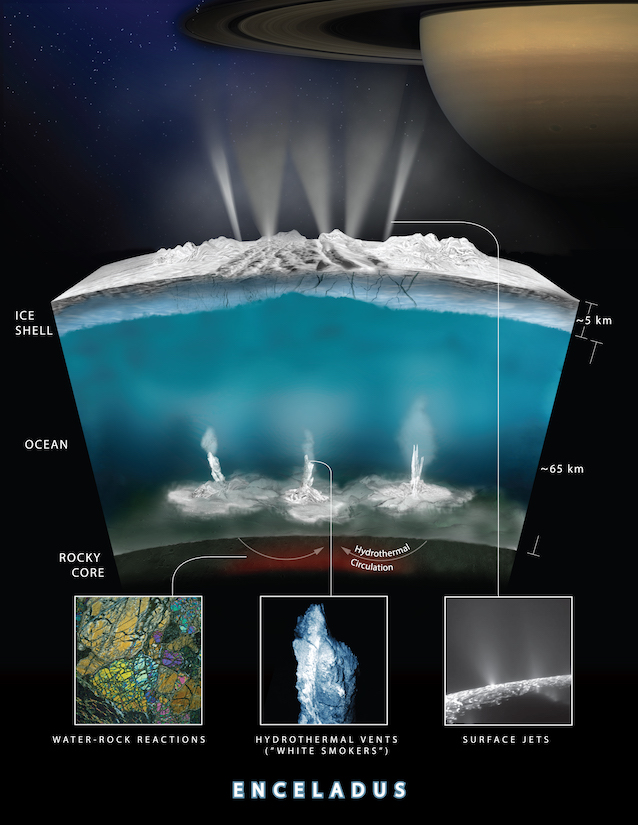
This article was originally published at AmericaSpace.com. Reprinted with permission.
NASA’s upcoming James Webb Space Telescope (JWST) will be used to study two of the most fascinating moons in our solar system – Europa and Enceladus, also known as ocean worlds since both have global oceans of water beneath their outer icy surfaces. The new observations will help scientists learn more about conditions on these worlds and guide the development of future robotic missions.
Both moons are exciting targets since Europa’s surface has deposits of minerals thought to have come up from the ocean below, and Enceladus has huge plumes of water vapor erupting through fissures in the icy surface, originating from the subsurface ocean. Europa may also have plumes, which have been tentatively identified but not confirmed yet. Enceladus’ plumes also contain organic compounds of various complexities, which were sampled directly by the Cassini spacecraft multiple times.
Astronomer Heidi Hammel is executive vice president of the Association of Universities for Research in Astronomy (AURA). She is spearheading the effort to study our solar system with the Webb telescope. She said:
We chose these two moons because of their potential to exhibit chemical signatures of astrobiological interest.

Astronomers will use Webb’s near-infrared camera (NIRCam) to take high-resolution images of Europa’s surface, to search for hot regions related to plumes and active geological processes. If a plume is found, they can then use Webb’s near-infrared spectrograph (NIRSpec) and mid-infrared instrument (MIRI) to analyze the plume’s composition. This video below shows possible results of using spectroscopy on Europa’s water plumes, obtainable using the Webb telescope’s NIRSpec instrument.
Geronimo Villanueva, a planetary scientist at NASA’s Goddard Space Flight Center in Greenbelt, Maryland, is the lead scientist on the Webb telescope’s observation of Europa and Enceladus. He said:
Are they made of water ice? Is hot water vapor being released? What is the temperature of the active regions and the emitted water? Webb telescope’s measurements will allow us to address these questions with unprecedented accuracy and precision.
JWST will be able to study Enceladus’ plumes and surface in a similar manner, even though it is about 10 times smaller than Europa as seen by the telescope.
For both moons, a focus will be to search for organic signatures such as methane, methanol, and ethane in the plumes. Evidence of life itself, like microbes, would be more difficult since some life-like processes could also have a geological explanation. Villanueva noted:
We only expect detections if the plumes are particularly active and if they are organic-rich.
JWST is the successor to the Hubble Space Telescope (HST) and will be the most powerful space-based telescope ever built. It is an international project led by NASA, along with the European Space Agency (ESA) and the Canadian Space Agency (CSA).
Even if JWST isn’t able to find signs of life on either moon, it will be another huge step in understanding what conditions are like, both on their surfaces and below the ice in the oceans themselves, building on results from spacecraft such as Galileo and Cassini. It will help prepare the way for future, more advanced probes on the drawing boards now which may be able to answer that question of whether life has ever existed on (in) these far-off ocean worlds.

Bottom line: The James Webb Space Telescope will be used in part to study our own solar system, for example, Jupiter’s moon Europa and Saturn’s moon Enceladus, both considered ocean worlds.











